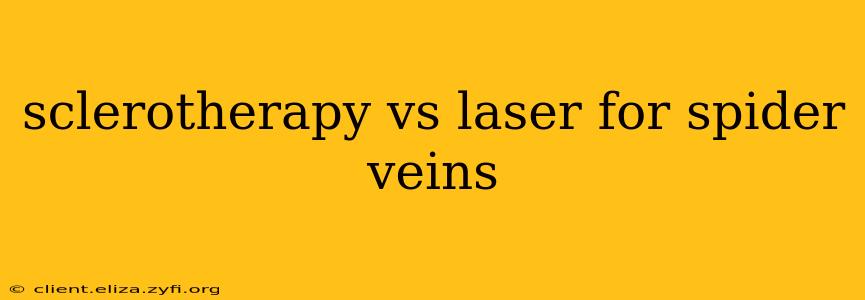Spider veins, those tiny, bluish-purple, web-like blood vessels near the skin's surface, are a common cosmetic concern. While they're generally harmless, many people seek treatment to improve their appearance. Two popular methods for spider vein removal are sclerotherapy and laser treatment. Choosing the best option depends on several factors, and understanding the differences is key to making an informed decision. This comprehensive guide will explore sclerotherapy and laser treatment, comparing their effectiveness, side effects, and suitability for different individuals.
What is Sclerotherapy?
Sclerotherapy is a minimally invasive procedure where a solution (sclerosant) is injected directly into the spider vein. This solution irritates the vein's lining, causing it to collapse and eventually fade from view. The body then reabsorbs the treated vein over several weeks.
Advantages of Sclerotherapy:
- Highly effective: Sclerotherapy boasts a high success rate for treating spider veins, often resulting in significant improvement or complete removal.
- Relatively low cost: Compared to laser treatment, sclerotherapy is generally less expensive.
- Minimal downtime: Most patients experience minimal downtime after the procedure.
Disadvantages of Sclerotherapy:
- Multiple sessions may be needed: Depending on the extent of the spider veins, multiple treatment sessions may be required to achieve optimal results.
- Potential side effects: Although rare, side effects can include bruising, swelling, pain, and discoloration at the injection site.
- Not suitable for all vein types: Sclerotherapy may not be as effective for larger veins or those deeper within the skin.
What is Laser Treatment for Spider Veins?
Laser treatment uses intense pulsed light (IPL) or laser energy to heat and destroy the spider veins. The heat causes the vein walls to collapse, leading to their eventual disappearance.
Advantages of Laser Treatment:
- Treats larger areas quickly: Laser treatment can treat larger areas of spider veins more quickly than sclerotherapy.
- Minimal discomfort: Many patients report minimal discomfort during laser treatment.
- Less bruising: Compared to sclerotherapy, laser treatment often results in less bruising.
Disadvantages of Laser Treatment:
- Higher cost: Laser treatment is typically more expensive than sclerotherapy.
- May require multiple sessions: Similar to sclerotherapy, multiple sessions might be necessary for optimal results.
- Potential side effects: Possible side effects include redness, swelling, blistering, and changes in skin pigmentation.
Sclerotherapy vs. Laser: Which is Better?
There's no single "better" treatment; the ideal choice depends on individual factors like:
- Type and location of spider veins: Sclerotherapy is often preferred for smaller, superficial veins, while laser treatment might be better suited for larger or more widespread veins.
- Skin type and tone: Laser treatment may be less effective on darker skin tones due to the risk of hyperpigmentation.
- Budget and insurance coverage: Sclerotherapy is generally less expensive.
- Pain tolerance and downtime preferences: Patients with low pain tolerance may prefer laser treatment, while those with limited downtime might opt for sclerotherapy.
How Much Does Each Treatment Cost?
The cost of both sclerotherapy and laser treatment varies depending on several factors, including the extent of the treatment area, the number of sessions needed, and the geographical location. It’s best to contact a vein specialist or dermatologist for a personalized cost estimate.
What are the Recovery Times for Each Treatment?
Recovery times are generally short for both treatments. For sclerotherapy, you may experience mild bruising and swelling for a few days. For laser treatment, redness and swelling might last for a few hours to a couple of days. Your doctor will provide specific post-treatment instructions.
Are There Any Long-Term Side Effects?
Long-term side effects are rare for both sclerotherapy and laser treatment. However, there’s a small risk of scarring, discoloration, or recurrence of spider veins. Following your doctor's instructions carefully can minimize the risk of complications.
Which Treatment is Best for My Skin Type?
The best treatment depends on your individual skin type and tone. A consultation with a dermatologist or vein specialist will help determine the most appropriate treatment for your specific needs. Laser treatments may be less effective or carry a higher risk of complications for darker skin tones.
Conclusion:
Both sclerotherapy and laser treatment are effective options for removing spider veins, each with its own advantages and disadvantages. A thorough consultation with a qualified healthcare professional is essential to determine the best treatment plan based on your individual needs and preferences. They can assess your veins, skin type, and medical history to recommend the most suitable and safe approach for achieving your desired results.
